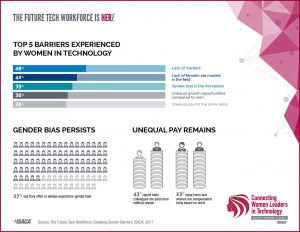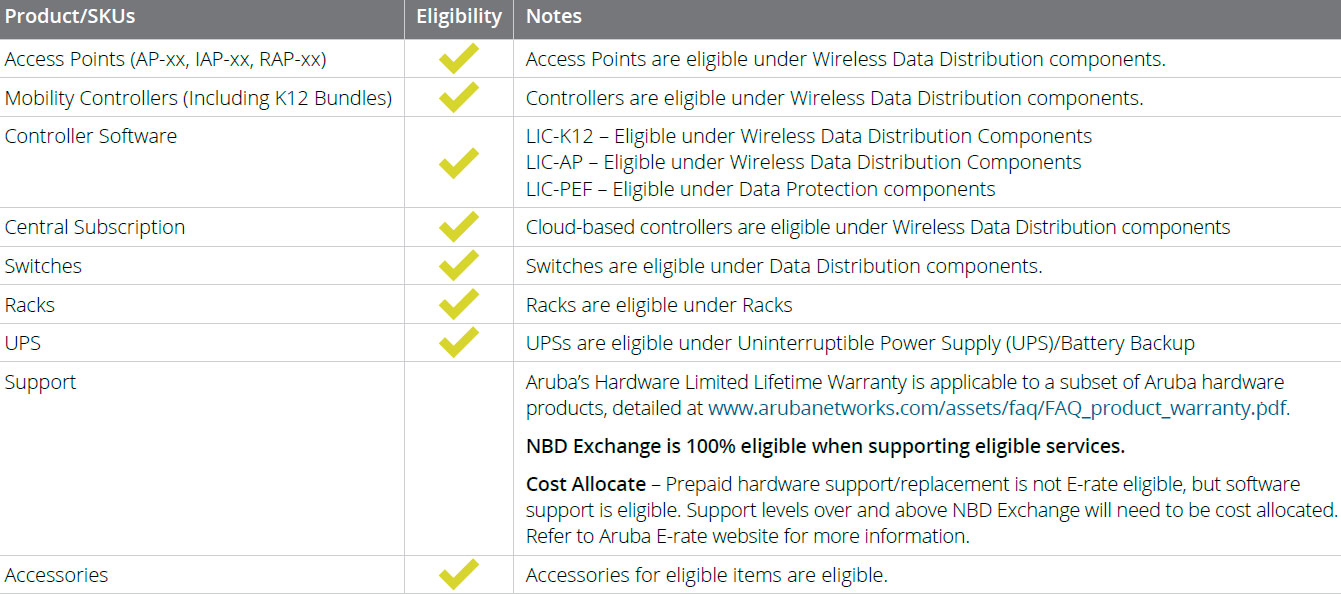Women in the Workplace
Organizations that do not want women in their workplace are, frankly, out of luck. Women currently make up 47% of the US workforce and 51% of all management, professional, and related positions (Bureau of Labor Statistics, 2017; DeWolf, 2017). Globally, the outlook is similar, with women accounting for 49% of the workforce (International Labor Organization, 2016). In the tech industry, women make up less than 20 percent of U.S. tech jobs, even though they make up more than half of the U.S. workforce. The infographic below showcases some of the challenges women still face in the tech industry.

ISACA’s 2017 Women in Technology Survey
Benefits of Recruiting Women
Financial Gain
According to Cathleen Clerkin with the Center for Creative Leadership (CCL), besides doubling your talent pool, recruiting women into your organization may also increase your company’s financial performance. Previous research shows that Fortune 500 companies with the highest representation of women on boards, financially outperform companies with the lowest representation of women on boards. Moreover, gender-diverse teams have higher sales and profits compared to male-dominated teams and a recent Gallup study found that gender-diverse business units have higher average revenue than less diverse business units.
Increase Morale
But women might do more than boost the bottom line. In a study by CCL , they found that having more women in your organization might actually make your organization a better place to work. Specifically, survey respondents estimated what percentage of individuals in their workplace were women. Answers ranged from 0–100%, with the average being about 45% (close to the national average). Having a higher percentage of women in an organization predicted:
• More job satisfaction
• More organizational dedication
• More meaningful work
• Less burnout
Increased Engagement and Retention
In addition to this, having more women in the workplace also was positively related to employee engagement and retention. Specifically, when asked why they stay with their current employer, people from organizations with a high percentage of women were more likely to cite positive and meaningful organizational culture, including having
• Enjoyable work
• A job that fits well with other areas of their life
• Opportunities to make a difference
These new findings persist even when controlling for differences in participants’ age, industry, organization size, leadership level, ethnicity, and gender. In fact, while both men and women in the CCL survey responded with the same positive pattern of results, their findings were even stronger for men on some measures—specifically being satisfied with their job, enjoying their work, and not feeling burned out. Thus, in the CCL sample set, having more women in an organization is associated with positive organizational outcomes for both men and women.
What can organizations and leaders do?
The findings from the Center for Creative Leadership suggest that organizations without a strong representation of women are missing out on opportunities to get better talent, make more money, and have more satisfied and dedicated employees. It also suggests that percentages of women matter. It might not be enough for organizations to employ “token” women if they want to reap the multiple benefits of a gender-diverse workplace. Leaders should take a careful look at the gender balance in their organizations. If women are still the minority, they should try to hire more women. As a bonus, organizations that have more women also attract and retain more women. Investing in women now will likely make it easier for an organization to have more women down the road.
E-Rate – “Free Money” from the Government for Education Customer Networks!
As a “go-to” E-rate services provider for our valued networking partners, Aruba Networks and Extreme Networks, we have discovered that many hundreds of millions of unspent “E-Rate” monies are still available to customers in the Rocky Mountain Region. This includes K-12 education as well as many libraries, and some child development (pre-K) centers. E-Rate is a great way to refresh aging networking equipment in all or part of your organization and have a large portion of the costs paid for by the US government. Below are some frequently asked questions we wanted to share and answer. We find that many smaller entities may not be aware of this program or the fact that they have “money to spend”. Zunesis can help them design and implement E-rate compliant, modern, and rugged internal network connection (wired and wireless) infrastructures.
What is E-Rate?
The Universal Service Schools and Libraries Program – commonly known as the E-rate program – provides discounts on telecom, internet access, and internal connections to eligible schools and libraries. E-rate is funded through the Universal Service Fund (USF). You will see a small fee at the end of each of your land line or wireless service phone bill. This small fee is collected to help fund this program along with additional federal funding. The Federal Communications Commission (FCC) writes the rules and standards for this program. The administrator of the E-rate program is the Universal Service Administrative Company (USAC).
Have you received your E-rate funding and how is funding determined?
Did you know that all applicants who submitted an eligible and timely E-rate application in 2015 through 2019 will receive their funding? Many schools have yet to take advantage of the over $4 billion dollars in available E-rate funding. For K-12/charter schools, E-rate discounts range from 20% to 90% of eligible project costs. Discounts are district wide, and an applicant’s discount rate is determined by the percentage of students that qualify for a free or reduced-price lunch.
How do I choose a Service Provider?
A service provider like Zunesis needs to be selected as part of a specific and regimented bidding process. E-rate applicants must conduct a fair and open competitive bidding process. All applicants must select the most cost-effective service provider. The price of the eligible products and services must be the most heavily weighed bid evaluation factor. Although other factors such as local presence to the state/community, service provider expertise on the proposed product, and ability to provide a complete solution (including implementation) may be other important weighing factors.
Why apply for E-Rate funding this year?
There has never been a better time to apply for E-rate funding. Because of the increased funding cap, available roll-over funds, and remaining Category Two (aka. “Internal Connections” such as wired switches and wireless access points) maximum budget funds, it is likely that there will be enough funding to support the entire demand in the current fiscal year as well. Also, applicants that seek E-rate funding this year will not have to compete for dollars against the applicants that will have their Category Two budgets refresh in future fiscal years (2020 and beyond).
How do I apply for E-Rate funding?
To apply for E-rate funding, simply follow the 6-step process outlined in Figure 1 below:

How do I determine if product is E-rate eligible?
It’s important to note that not all networking solutions are E-rate eligible. For example, you can find eligibility of Aruba products using their E-rate Eligibility Lookup Tool.
The following table highlights products that are eligible under the current E-rate program from Aruba Networks as a for-instance.

How can Zunesis help?
Zunesis believes in working with our E-rate eligible clients well prior to “step 1” of the above chart to help educate the customer on some of the best available options for their particular environments. As not all customer needs are the same, we feel it is always best to have a face to face meeting to walk through example environments, discuss customer needs, and provide valuable input into the Competitive Bid process. Please contact your Zunesis account manager to setup your E-Rate readiness review today!
Additional Resources
Aruba Networking Education Solutions
Microsoft, a year ago, announced that they are bringing the capabilities of Skype for Business in the cloud into Microsoft Teams to deliver a single hub for teamwork, with built-in, fully integrated voice and video.
According to Microsoft, “As users are working on more teams, we see the opportunity to more seamlessly integrate our communication capabilities into Teams so users can have a single place for their conversations, contacts, and content. We believe Teams also provides a modern cloud infrastructure that enables us to take advantage of our assets for artificial intelligence such as AI, Microsoft Graph, and LinkedIn to deliver intelligent communications. With Teams, we’re creating new experiences for meetings and calling, including the prep, delivery, and post–follow-ups.”
What will this mean for current users of Skype for Business?
While the recommendation for Office 365 users is to move to Teams, the Skype for Business on premises infrastructure is not going away anytime soon, in fact, a new version (Skype for Business Server 2019) is in preview and should be released later this year. Even though there is a new version of the on premises solution, it is clear that Teams is where the innovation dollars are going.
What Can Teams Bring to Your Organization?
Teams started as Microsoft’s implementation of Slack with deep integrations into Office 365 applications. As of September 2017, Microsoft reported 125,000 organizations were using it in one form or another.
PLATFORM FOR TODAY’S WORK TEAMS
Teams is built for today’s diverse workforce. There have been many changes across the methods that organizational teams use to communicate and collaborate. Teams provides an open, digital environment that makes work integrated, visible, and accessible across the board, keeping everyone involved in the know.
Microsoft Teams provides a versatile conversation experience using persistent threaded conversations. Every conversation within Teams automatically becomes information assets and are saved, searchable via Microsoft Graph, and visible to everyone on the team. It also provides the ability of launching private discussions.
Teams’ deep Skype integration brings video and voice capabilities and a wide variety of visual communication tools that help increase engagements among team members.
COMPLETE ONLINE MEETING SOLUTION
- Online Meetings – Host audio, video and web conferencing with anyone inside or outside the organization. Features include scheduling assistant, note taking, desktop sharing, file sharing, and chat messaging.
- Live Broadcasts – For big meetings, go live with Teams Meeting Broadcast. Host webinars, all-hands meetings, and other one-to-many presentations with up to 10,000 attendees internal or external to the organization.
- Meeting Spaces – Extend Teams with one-touch join to every meeting space with Microsoft Surface Hub.
- Cloud Video Meetings – Microsoft Partners are delivering video solutions which seamlessly connect H.323 compatible videoconferencing solutions to Teams meetings.
- Audio Conferencing – Join meetings from a phone or use Teams to dial anybody directly. Meetings include a local dial-in number spanning 400+ cities across the globe.
PRODUCTIVITY
The ability to meet virtually anywhere is an important and cost-effective feature for businesses. Teams increases productivity by bringing together conversations, meetings, files, Office applications, and third-party integrations, enabling the organization to participate in more productive meetings with less context switching. It provides a view of scheduled meetings, the timing, the subject, and a list of other persons who’ll be attending.
Teams also provides simple and easy to use mobile apps that allow chat with teams via text, have a voice conversation, or a video meeting.
COLLABORATION
Teams makes teamwork easy. Teams was built around the idea of leveraging the maximum capability of Microsoft Graph, so workgroups and teams have the ability to share insights, intelligence, and data anywhere within the Microsoft Office 365 suite; PowerPoint, Excel, Word, Planner, OneNote, SharePoint, Delve, and Power BI.
CUSTOMIZATION
Teams can be tailored to meet unique business and cultural needs of the organization. Teams provides a platform with options for extensibility and open APIs. Through the leveraging of Microsoft Exchange Connector’s model, Teams can provide updates and notifications from third-party services such as GitHub and Twitter. Along with Microsoft’s BOT Framework, organizations are able to create and customize applications and intelligent services to integrate with Teams.
SECURITY
Teams stands apart from its competitors and ensures peace of mind. All of Office 365’s platform services are built with cutting-edge security and compliance capabilities. The data is encrypted in flight and at rest. Teams and all Office 365 services meet compliance standards including ISO 27001, HIPPA, SOC 2, and the EU Model Clauses. The Teams account is provisioned within Office 365 and managed via the Admin console.
In conclusion, Microsoft has taken many of the features provided in Skype for Business and built them into the Teams platform. This platform is built with today’s organizational work teams in mind, providing a complete online meeting solution, increased productivity and collaboration, all built on Office 365’s already secure services infrastructure. Even though Microsoft has announced that Skype for Business will be going away in the future, the on-premises version has one release version left (later this year). Office 365 users are being pushed to Teams instead of Skype for Business in the cloud.
Do you have control of your Office 365 data? Do you have access to all the items you need?
The typical reaction is, “Microsoft takes care of it all.”
Microsoft takes care of quite a bit and provides a great service for their customers. However, Microsoft’s primary focus is on managing the Office 365 infrastructure and maintaining uptime to users. They are empowering YOU with the responsibility of your data. The misconception that Microsoft fully backs up your data on your behalf is quite common, and without a shift in mindset, could have damaging repercussions when this responsibility is left unattended. Ultimately, you need to ensure you have access to, and control over, your Exchange Online, SharePoint Online and OneDrive for Business data.
The misunderstanding falls between Microsoft’s perceived responsibility and the user’s actual responsibility of protection and long-term retention of their Office 365 data. The backup and recoverability that Microsoft provides and what users assume they are getting are often different. Meaning, aside from the standard precautions Office 365 has in place, you may need to re-assess the level of control you have of your data and how much access you truly have to it.
As a robust and highly capable Software as a Service (SaaS) platform, Microsoft Office 365 fits the needs of many organizations perfectly. Office 365 provides application Availability and uptime to ensure users never skip a beat, but an Office 365 backup can protect you against many other security threats.
6 reasons why backing up
Office 365 is critical
1. Accidental Deletion
If you delete a user, whether you meant to or not, that deletion is replicated across the network, along with the deletion of their personal SharePoint site and their OneDrive data. Native recycle bins and version histories included in Office 365 can only protect you from data loss in a limited way, which can turn a simple recovery from a proper backup into a big problem after Office 365 has geo-redundantly deleted the data forever, or it has fallen out of the retention period.
There are two types of deletions in the Office 365 platform, soft delete and hard delete. An example of soft delete is emptying the Deleted Items folder. It is also referred to as “Permanently Deleted.” In this case, permanent is not completely permanent, as the item can still be found in the Recoverable Items mailbox. A hard delete is when an item is tagged to be purged from the mailbox database completely. Once this happens, it is unrecoverable, period.
2. Retention Policy Gaps and Confusion
The fast pace of business in the digital age lends itself to continuously evolving policies, including retention policies that are difficult to keep up with, let alone manage. Just like hard and soft delete, Office 365 has limited backup and retention policies that can only fend off situational data loss and is not intended to be an all-encompassing backup solution.
Another type of recovery, a point-in-time restoration of mailbox items, is not in scope with Microsoft. In the case of a catastrophic issue, a backup solution can provide the ability to roll back to a previous point-in-time prior to this issue and saving the day.
With an Office 365 backup solution, there are no retention policy gaps or restore inflexibility. Short term backups or long-term archives, granular or point-in-time restores, everything is at your fingertips making data recovery fast, easy and reliable.
3. Internal Security Threats
The idea of a security threat suggests hackers and viruses. However, businesses experience threats from the inside, and they are happening more often than you think. Organizations fall victim to threats posed by their very own employees, both intentionally and unintentionally.
Access to files and contacts changes so quickly, it can be hard to keep an eye on those in which you’ve installed the most trust. Microsoft has no way of knowing the difference between a regular user and a terminated employee attempting to delete critical company data before they depart. In addition, some users unknowingly create serious threats by downloading infected files or accidentally leaking usernames and passwords to sites they thought they could trust.
Another example is evidence tampering. Imagine an employee strategically deleting incriminating emails or files — keeping these objects out of the reach of the legal, compliance or HR departments.
4. External Security Threats
Malware and viruses, like ransomware, have done serious damage to organizations across the globe. Not only is company reputation at risk, but the privacy and security of internal and customer data as well.
External threats can sneak in through emails and attachments, and it isn’t always enough to educate users on what to look out for — especially when the infected messages seem so compelling. Exchange Online’s limited backup/recovery functions are inadequate to handle serious attacks. Regular backups will help ensure a separate copy of your data is uninfected and that you can recover quickly.
5. Legal and Compliance Requirements
Sometimes you need to unexpectedly retrieve emails, files or other types of data amid legal action. Microsoft has built in a couple safety nets, (Litigation Hold) but again, these are not a robust backup solution capable of keeping your company out of legal trouble. For example, if you accidentally delete a user, their on-hold mailbox, personal SharePoint site and OneDrive account is also deleted.
Legal requirements, compliance requirements and access regulations vary between industries and countries, but fines, penalties and legal disputes are three things you want to avoid.
6. Managing Hybrid Email Deployments and Migrations to Office 365
Organizations that adopt Office 365 typically need a window of time to serve as a transition window between on-premises Exchange and Office 365 Exchange Online. Some even leave a small portion of their legacy system in place to have added flexibility and additional control. These hybrid email deployments are common yet pose additional management challenges.
The right Office 365 backup solution should be able to handle hybrid email deployments, and treat exchange data the same, making the source location irrelevant.
Conclusion
Whether you are considering moving your organization to Microsoft Office 365 or have already embraced the benefits of Office 365 within your organization, find a backup solution that offers you both complete access and complete control of your Office 365 data and avoid the unnecessary risks of data loss.




